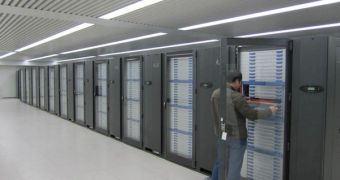Intel's goal of going “inside” as many computing solutions as possible is very well on track, and it seems that the chip manufacturer is decided not to limit itself to servers, desktops, notebooks, netbooks and tablets, but's also keen to move to something a little more...breathtaking, namely supercomputers. And that's because the world's currently fastest supercomputer, the Tianhe-1A, located at the National Supercomputing Center in Tianjin, China, contains 14,396 Intel Xeon 5600 series processors, accompanied by accelerator cards, managing to attain a very impressive performance level, namely 2.57 petaflops (quadrillions of calculations per second). However, Intel's not responsible just for the Tianhe-1A, the company's processors being found in some of the other contenders from TOP500 list of supercomputers – around 80 percent of them, to be perfectly accurate. Furthermore, according to the list, Intel chips now power three of the top five systems – in addition to the No. 1 system. Hence, Xeon 5600 series processors are a key building block in the No. 3 system (Shenzhen), and the newly listed No. 4 system at the Tokyo Institute of Technology. Additionally, the New Intel Xeon Processor 7500 series is featured in the Bull Supernode system at CEA, newly listed at No. 6, which is powered by 17,296 Intel chips. Another notable supercomputer hails from the Tokyo Institute of Technology. Featuring Xeon 5600 series processors within an NEC/HP system, this No. 4-ranked supercomputer achieved 2.4 petaflops. “Our Xeon processor roadmap continues to deliver hugely powerful supercomputers that are helping solve mankind’s greatest challenges,” said Rajeeb Hazra, general manager of Intel’s High Performance Computing organization.
“Securing the top position on the Top500 is also a source of great pride for us, and demonstrates the tremendous leaps in performance and versatility that our processors are delivering across a range of compelling workloads,” concluded Mr. Hazra.

 14 DAY TRIAL //
14 DAY TRIAL //